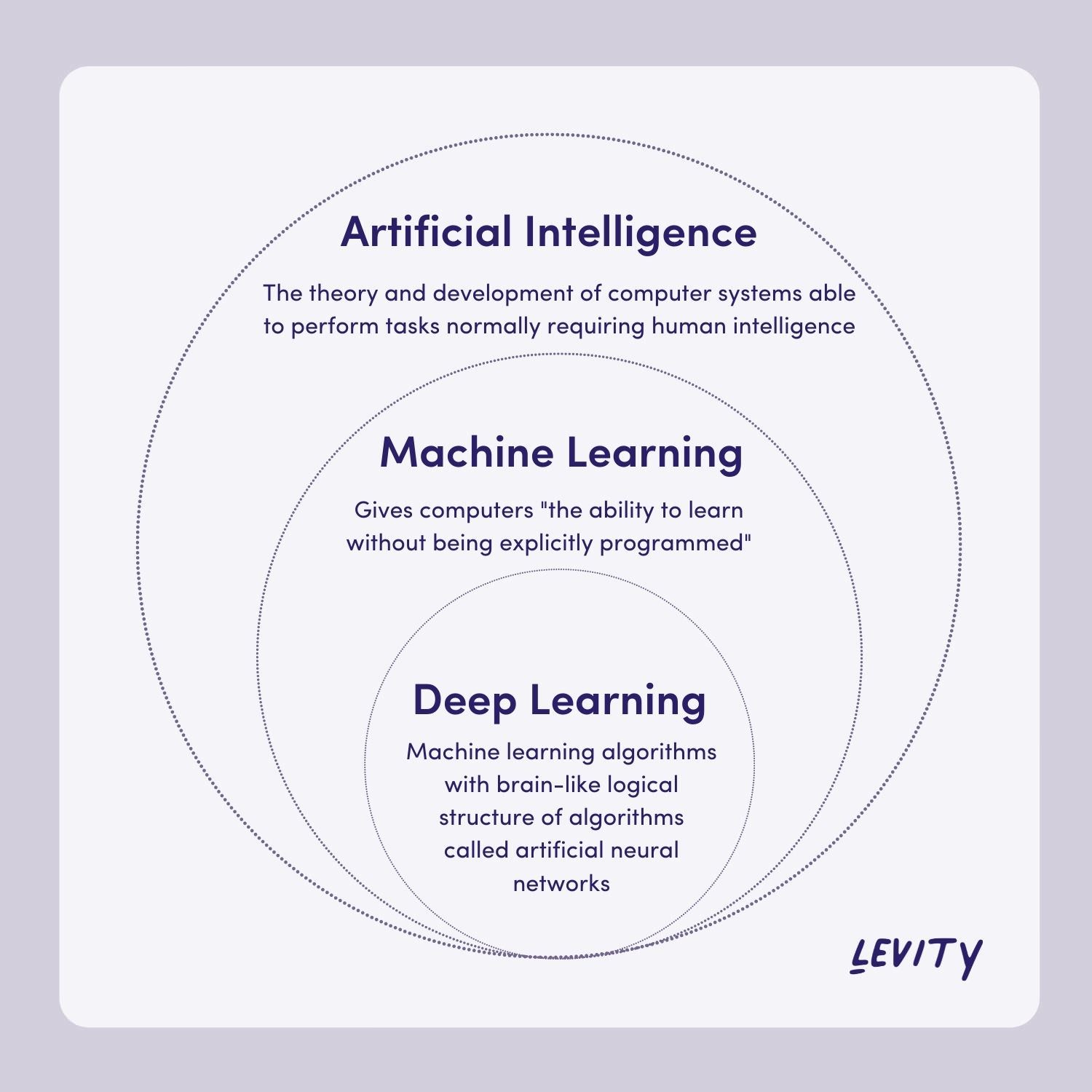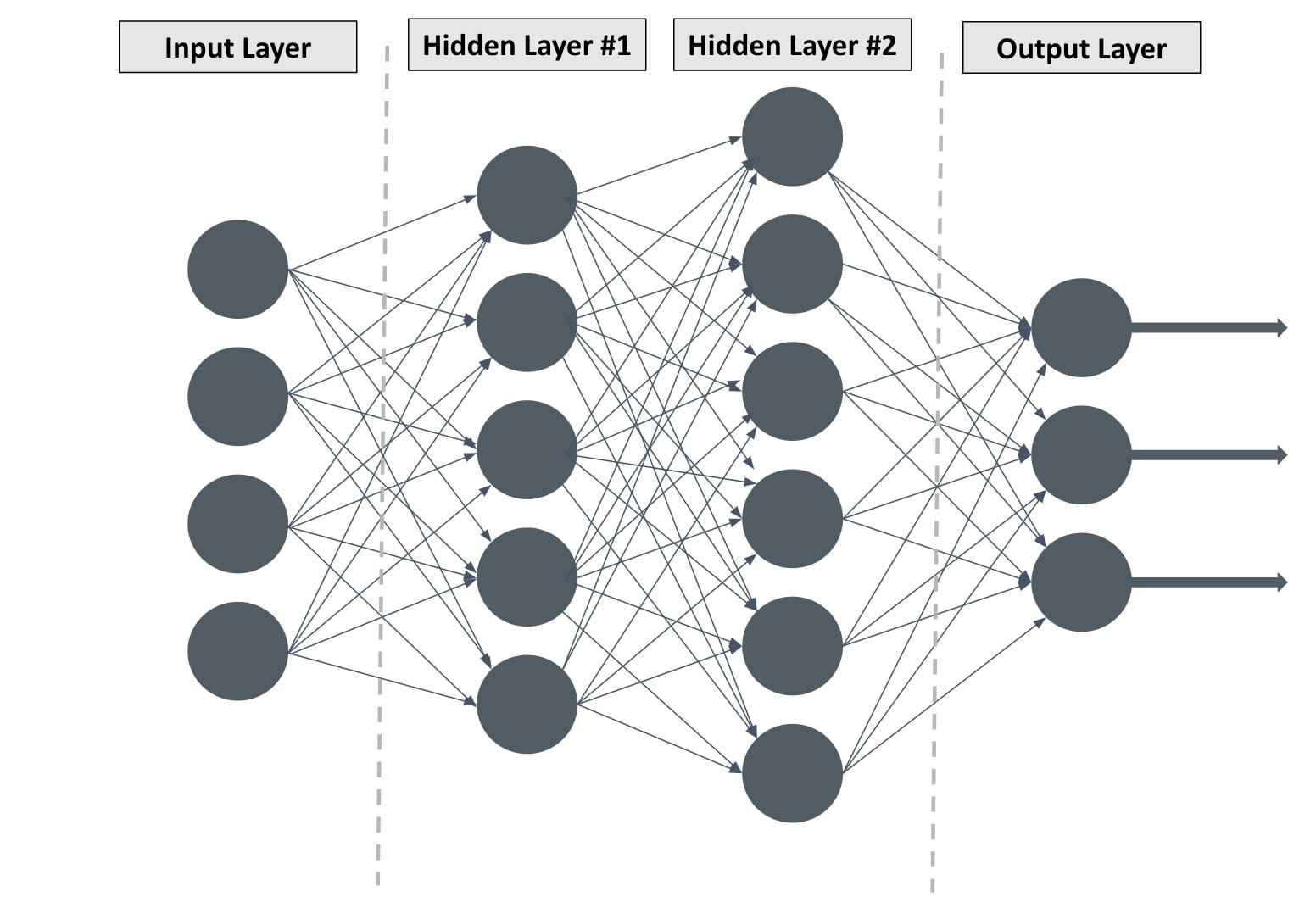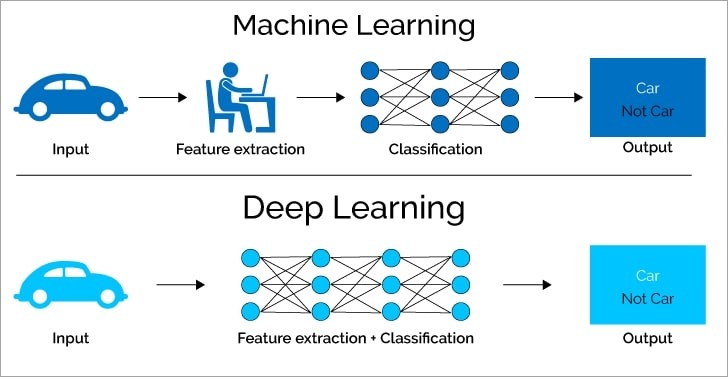Deep learning versus machine learning – understanding the nuances is crucial in today’s AI-driven world. This comprehensive guide from LEARNS.EDU.VN will explore the defining characteristics, applications, and benefits of each, providing a clear roadmap for navigating the landscape of artificial intelligence and unlocking the potential of these powerful techniques. Embrace the future of technology with knowledge, intelligent algorithms, and data analysis.
1. Defining Machine Learning
Machine learning empowers computers to learn from data without explicit programming. It is an interdisciplinary field merging computer science and statistics, where algorithms identify patterns and make predictions on new data. This process enables systems to improve performance autonomously.
1.1. Supervised vs. Unsupervised Learning
Machine learning algorithms learn through supervised or unsupervised methods, depending on the data available.
- Supervised learning: Uses labeled data to train a model to predict outcomes.
- Unsupervised learning: Works with unlabeled data to find hidden patterns and structures.
1.2. A Simple Machine Learning Example
Consider predicting income based on years of education. A simple linear regression model can be used:
Income = y + x * Years of EducationThe algorithm learns from training data, such as a table of people’s education years and incomes. It then draws a line (regression) to predict income based on education levels. This illustrates machine learning’s ability to make predictions based on patterns in data.
Alt Text: Visual representation of linear regression, illustrating how machine learning algorithms predict outcomes based on data.
1.3. Key Characteristics of Machine Learning
- Learning from Data: Computers learn without explicit programming.
- Interdisciplinary: Combines computer science and statistics.
- Supervised & Unsupervised: Employs different learning methods based on data.
2. Unveiling Deep Learning
Deep learning is an advanced evolution of machine learning algorithms. This field, garnering significant attention, has achieved previously unimaginable results.
2.1. How Deep Learning Works
Deep learning algorithms analyze data with a logical structure akin to human reasoning, using both supervised and unsupervised methods. This is achieved through layered algorithms called artificial neural networks (ANNs). The design mimics the human brain, resulting in superior learning capabilities compared to standard machine learning models.
2.2. Artificial Neural Networks (ANNs)
An ANN consists of interconnected nodes organized into layers:
- Input Layer: Receives initial data.
- Output Layer: Produces the final result.
- Hidden Layers: Intermediate layers that process the data.
The more hidden layers, the “deeper” the network. ANNs with two or more hidden layers are deep neural networks.
Alt Text: Diagram of an artificial neural network, showing input, hidden, and output layers, illustrating the structure of deep learning models.
2.3. Real-World Applications of Deep Learning
Deep learning is used across various sectors:
- Automated Driving: Detects objects like STOP signs and pedestrians.
- Military: Identifies objects from satellites for threat assessment.
- Consumer Electronics: Powers voice-activated assistants like Amazon Alexa.
2.4. Concrete Example: Tesla and STOP Signs
Imagine Tesla using a deep learning algorithm to recognize STOP signs:
- Feature Identification: The ANN identifies relevant properties of the STOP sign (features).
- Automatic Feature Engineering: Unlike traditional methods where engineers select features, the ANN automatically extracts them.
- Hidden Layers: First layer detects edges, the next differentiates colors, and the last learns complex shapes.
- Self-Learning: The algorithm learns from errors and adjusts predictions.
2.5. Factors Enabling Deep Learning
Deep learning’s recent usability is due to:
- Data Availability: Vast amounts of data for training.
- Computing Power: High-performance GPUs and cloud infrastructure.
- Transfer Learning: Using pre-trained models to reduce data needs.
2.6. Transfer Learning
Transfer learning involves using pre-trained models, addressing the need for large training datasets. This is a crucial advancement as it allows deep learning to be applied effectively with less data.
2.7. Key Characteristics of Deep Learning
- Subset of Machine Learning: A specialized area within machine learning.
- Artificial Neural Networks: Uses layered algorithms modeled on the human brain.
- Minimal Human Intervention: Requires less manual feature selection.
- Data-Intensive: Typically needs large datasets, but can be mitigated by transfer learning.
3. Key Distinctions: Machine Learning vs. Deep Learning
Deep learning algorithms are machine learning algorithms. The key differences lie in the algorithm structure, the degree of human intervention needed, and data requirements.
3.1. Algorithm Structure
- Machine Learning: Uses simpler structures like linear regression or decision trees.
- Deep Learning: Employs complex, multi-layered artificial neural networks.
3.2. Human Intervention
- Machine Learning: Requires manual feature selection and algorithm adjustment.
- Deep Learning: Automates feature extraction and learns from its own errors.
3.3. Data Requirements
- Machine Learning: Can function with smaller datasets (thousands of data points).
- Deep Learning: Typically requires massive datasets (millions of data points) for optimal performance.
Alt Text: Illustration comparing machine learning and deep learning processes, highlighting automatic feature engineering in deep learning.
4. Machine Learning vs Deep Learning: A Comprehensive Comparison Table
To further clarify the differences between machine learning and deep learning, consider the following table:
| Feature | Machine Learning | Deep Learning |
|---|---|---|
| Algorithm Structure | Simpler (Linear Regression, Decision Trees) | Complex (Artificial Neural Networks) |
| Human Intervention | High (Manual feature selection) | Low (Automatic feature engineering) |
| Data Requirements | Smaller datasets (Thousands) | Larger datasets (Millions) |
| Feature Extraction | Manual | Automatic |
| Computational Power | Lower | Higher |
| Training Time | Shorter | Longer |
| Applications | Basic Predictions, Classification | Image Recognition, Natural Language Processing |
| Complexity | Lower | Higher |
| Interpretability | Easier to Interpret | Difficult to Interpret (Black Box) |
| Hardware Needs | Standard CPUs | GPUs Recommended |
| Transfer Learning | Less Common | More Common, Especially with Pre-trained Models |
| Data Preprocessing | More Required | Less Required Due to Automatic Feature Extraction |
| Examples | Spam Filtering, Credit Risk Assessment | Self-Driving Cars, Voice Assistants |



This table provides a detailed overview of the key differences between machine learning and deep learning, helping you understand which approach is best suited for your specific needs.
5. Diving Deeper: The Role of Data in Machine Learning and Deep Learning
Data is the lifeblood of both machine learning and deep learning. However, the amount, type, and preprocessing requirements differ significantly between the two.
5.1. Data Requirements
- Machine Learning: Effective with structured data and smaller datasets.
- Deep Learning: Requires vast amounts of unstructured data to achieve high performance.
5.2. Data Preprocessing
- Machine Learning: Data needs significant preprocessing, including feature scaling, handling missing values, and feature engineering.
- Deep Learning: Requires less preprocessing due to automatic feature extraction, but still benefits from data normalization and cleaning.
5.3. Data Quality
- Machine Learning: High-quality, representative data is crucial for accurate predictions.
- Deep Learning: While large datasets can compensate for some noise, data quality remains important for optimal performance.
5.4. Data Augmentation
- Machine Learning: Data augmentation techniques can help improve model performance with limited data.
- Deep Learning: Data augmentation is commonly used to increase dataset size and improve model generalization.
5.5. Data Sources
- Machine Learning: Data can come from databases, spreadsheets, and APIs.
- Deep Learning: Data often comes from images, audio, video, and text, requiring specialized data pipelines.
5.6. Data Labeling
- Machine Learning: Supervised learning relies on accurately labeled data for training.
- Deep Learning: While supervised learning is common, unsupervised and semi-supervised approaches are also used, reducing the need for extensive labeling.
6. Understanding the Computing Power and Hardware Requirements
The computational demands of machine learning and deep learning differ significantly, impacting the hardware required to train and deploy models.
6.1. Machine Learning
- Computing Power: Can run on standard CPUs with moderate processing power.
- Hardware: Requires less specialized hardware, making it accessible for a wide range of applications.
6.2. Deep Learning
- Computing Power: Requires significant processing power, often utilizing GPUs (Graphics Processing Units) for faster computations.
- Hardware: Benefits from high-performance computing resources, including cloud infrastructure and specialized hardware accelerators.
6.3. Parallel Processing
- Machine Learning: Can benefit from parallel processing, but is not always necessary.
- Deep Learning: Heavily relies on parallel processing to handle complex computations and large datasets.
6.4. Training Time
- Machine Learning: Training times are generally shorter, ranging from minutes to hours.
- Deep Learning: Training times can be significantly longer, ranging from hours to weeks, depending on the model complexity and dataset size.
6.5. Energy Consumption
- Machine Learning: Consumes less energy due to lower computational demands.
- Deep Learning: Consumes more energy due to intensive processing requirements.
6.6. Scalability
- Machine Learning: Scalability is limited by the complexity of the algorithms and the available computing power.
- Deep Learning: Scalability can be improved by distributing the workload across multiple GPUs or cloud-based resources.
7. Applications and Use Cases: Where Machine Learning and Deep Learning Shine
Machine learning and deep learning excel in different domains, each with its unique set of applications and use cases.
7.1. Machine Learning Applications
- Spam Filtering: Classifies emails as spam or not spam.
- Credit Risk Assessment: Evaluates the creditworthiness of loan applicants.
- Recommendation Systems: Suggests products or content based on user preferences.
- Fraud Detection: Identifies fraudulent transactions in financial systems.
- Predictive Maintenance: Predicts when equipment will fail to optimize maintenance schedules.
- Customer Segmentation: Groups customers based on demographics and behavior.
- Medical Diagnosis: Assists in diagnosing diseases based on patient data.
7.2. Deep Learning Applications
- Self-Driving Cars: Detects objects, pedestrians, and road signs for autonomous navigation.
- Voice Assistants: Understands and responds to voice commands (e.g., Amazon Alexa, Google Assistant).
- Image Recognition: Identifies objects, faces, and scenes in images and videos.
- Natural Language Processing (NLP): Translates languages, analyzes sentiment, and generates text.
- Medical Image Analysis: Detects anomalies and assists in diagnosing diseases from medical images.
- Drug Discovery: Accelerates the identification and development of new drugs.
- Financial Forecasting: Predicts stock prices and market trends.
7.3. Hybrid Approaches
- Combining machine learning and deep learning techniques to leverage the strengths of both approaches.
- Using machine learning for feature engineering and deep learning for model training.
- Applying machine learning for preprocessing and data cleaning, followed by deep learning for complex pattern recognition.
8. Navigating the Coding Landscape: Deep Learning vs. Machine Learning
While both deep learning and machine learning require coding skills, the complexity and tools used can differ.
8.1. Machine Learning Coding
- Languages: Commonly uses Python, R, and Java.
- Libraries: Scikit-learn, a versatile library for various machine learning algorithms.
- Ease of Use: Generally easier to implement and requires less code.
8.2. Deep Learning Coding
- Languages: Primarily uses Python due to its extensive deep learning libraries.
- Frameworks: TensorFlow, Keras, and PyTorch are popular frameworks for building and training neural networks.
- Complexity: More complex and requires a deeper understanding of neural network architectures.
8.3. Low-Code and No-Code Platforms
- Emerging platforms like Levity allow users to build custom deep learning solutions without extensive coding skills.
- These platforms democratize AI, enabling individuals with domain expertise to leverage the power of deep learning.
8.4. Cloud-Based Solutions
- Cloud platforms like AWS, Google Cloud, and Azure provide tools and infrastructure for both machine learning and deep learning.
- These platforms offer scalable computing resources and pre-trained models, simplifying the development process.
8.5. Skills Required
- Machine Learning: Requires knowledge of statistics, data preprocessing, and algorithm selection.
- Deep Learning: Requires knowledge of neural network architectures, optimization techniques, and GPU programming.
9. Machine Learning and Deep Learning: Ethical Considerations and Future Trends
As machine learning and deep learning become more pervasive, it is crucial to address ethical considerations and stay informed about future trends.
9.1. Ethical Considerations
- Bias: Ensuring fairness and mitigating bias in algorithms and datasets.
- Transparency: Improving the interpretability and explainability of models.
- Privacy: Protecting sensitive data and ensuring compliance with privacy regulations.
- Accountability: Establishing clear lines of responsibility for the decisions made by AI systems.
9.2. Future Trends
| Trend | Description | Impact |
|---|---|---|
| Explainable AI (XAI) | Developing models that can explain their decisions and reasoning. | Increased trust and adoption, especially in critical applications like healthcare and finance. |
| Federated Learning | Training models across decentralized devices while keeping data private. | Enables collaborative learning without compromising user privacy. |
| TinyML | Deploying machine learning models on low-power embedded devices. | Brings AI to resource-constrained environments like IoT devices and wearable technology. |
| Quantum Machine Learning | Using quantum computers to accelerate machine learning algorithms. | Potential for significant speedups in training complex models. |
| Generative AI | Creating new data, images, and content using generative models. | Revolutionizing creative industries and enabling new forms of data augmentation. |
| Automated Machine Learning (AutoML) | Automating the process of selecting, training, and optimizing machine learning models. | Democratizes AI by making it accessible to non-experts. |
| Reinforcement Learning | Training agents to make decisions in an environment to maximize a reward. | Enables the development of autonomous systems and robotics. |
| Edge Computing | Processing data closer to the source, reducing latency and bandwidth requirements. | Improves the performance of real-time applications and enhances data security. |
9.3. Continuous Learning
- Staying updated with the latest research and developments in the field.
- Participating in online courses, workshops, and conferences.
- Experimenting with new tools and techniques to expand your knowledge and skills.
9.4. Lifelong Learning
- Adopting a mindset of continuous growth and intellectual curiosity.
- Embracing challenges and seeking opportunities to learn from failures.
- Building a strong foundation in mathematics, statistics, and computer science.
10. Frequently Asked Questions (FAQ) About Deep Learning vs. Machine Learning
Here are some frequently asked questions to help clarify the concepts of deep learning and machine learning:
- What is the main difference between deep learning and machine learning?
- Deep learning is a subset of machine learning that uses artificial neural networks with multiple layers (deep neural networks) to analyze data. Machine learning encompasses a broader range of algorithms for learning from data.
- When should I use machine learning vs. deep learning?
- Use machine learning when you have structured data, smaller datasets, and need interpretable results. Use deep learning when you have large amounts of unstructured data, require high accuracy, and have sufficient computational resources.
- Do I need a GPU for machine learning?
- Not always. Machine learning algorithms can often run on CPUs, especially with smaller datasets. However, GPUs can significantly speed up training for certain algorithms.
- What are the prerequisites for learning deep learning?
- A solid understanding of linear algebra, calculus, probability, statistics, and programming (preferably Python) is essential.
- Is deep learning always better than machine learning?
- No, deep learning is not always better. It depends on the specific problem, data availability, and computational resources. Machine learning algorithms can be more efficient and interpretable for certain tasks.
- Can I use deep learning for small datasets?
- While deep learning typically requires large datasets, techniques like transfer learning and data augmentation can help improve performance with smaller datasets.
- What are the popular deep learning frameworks?
- TensorFlow, Keras, and PyTorch are among the most popular deep learning frameworks, offering tools and resources for building and training neural networks.
- How can I get started with deep learning?
- Start with online courses, tutorials, and documentation for deep learning frameworks. Practice building simple models and gradually increase the complexity as you gain experience.
- What is the role of feature engineering in deep learning?
- Deep learning automates feature extraction, reducing the need for manual feature engineering. However, careful data preprocessing and feature selection can still improve model performance.
- Are machine learning and deep learning only for tech companies?
- No, machine learning and deep learning are being applied across various industries, including healthcare, finance, manufacturing, and education, to solve complex problems and create new opportunities.
Unlock Your Potential with LEARNS.EDU.VN
Ready to dive deeper into the world of machine learning and deep learning? At LEARNS.EDU.VN, we offer comprehensive resources to help you master these essential skills.
- Detailed Guides: Explore our easy-to-understand articles on various AI topics.
- Effective Learning Methods: Discover proven techniques to enhance your learning process.
- Simplified Concepts: Grasp complex ideas with our clear and intuitive explanations.
- Clear Learning Paths: Follow structured roadmaps to achieve your learning goals.
- Useful Resources: Access a wealth of valuable tools and materials to support your studies.
- Expert Connections: Connect with experienced educators for personalized guidance.
Take the Next Step
Don’t let the complexities of AI hold you back. Visit LEARNS.EDU.VN today to unlock a world of knowledge and opportunities. Our resources are designed to empower you with the skills and insights you need to succeed in the age of artificial intelligence.
Contact Us:
- Address: 123 Education Way, Learnville, CA 90210, United States
- WhatsApp: +1 555-555-1212
- Website: LEARNS.EDU.VN
Start your journey with learns.edu.vn and transform your understanding of machine learning and deep learning today.